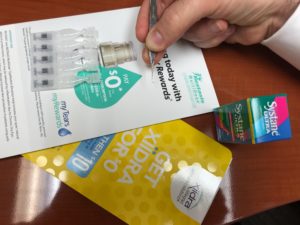
By: Nathan Klein O.D.
Do your eyes sting and feel scratchy or frequently tear? Though this question may sound counterintuitive, both may be symptoms of Dry Eye Syndrome.
As healthy adults, our eyes are constantly producing tears. These tears help wash away irritations, provide lubrication and help keep the surface of the eye nice and smooth. If your eyes do not produce enough tears or the right type of tears or tear film or tear frequently, you could be diagnosed with Dry Eye Syndrome.
There are two main types of Dry Eye Syndrome: Aqueous Deficient Dry Eye and Evaporative Dry Eye, with many dry eye patients having a combination of the two.
Here is a list of symptoms according to the American Academy of Ophthalmology:
- Stinging and burning eyes
- Scratchy or gritty feeling like something is in your eye
- Strings of mucus in or around your eyes
- Red or irritated eyes
- Discomfort when wearing contact lenses
- An overabundance of tears at random times
The Causes of Dry Eye Syndrome:
Both men and women can be diagnosed with Dry Eye Syndrome, though it tends to be more prevalent in women due to hormonal changes, particularly during menopause.
Other diseases such as thyroid disease, lupus, Sjogren’s syndrome and rheumatoid arthritis tend to cause dry eyes. Environmental factors, such as smoke or living in a super dry climate, can also trigger dry eyes, as does extensive use of contact lenses and computer work. Finally, certain medications, such as beta blockers for high blood pressure, antihistamines and sleeping pills, can contribute to eyes which burn, are red and irritated.
The Treatment
There are many ways to properly treat Dry Eye Syndrome, starting with the least invasive and over the counter measures:
Artificial Tear Drops: Many people benefit from artificial tear drops that are widely available over the counter. When selecting an over-the-counter product, make sure the label specifies that the product contains lubricant eye drops, not the ones which promise to “get the red out.” We recommend refrigerating the drops because at lower temperatures they are more readily absorbed by your eyes.
Prescription Eye Drops: Currently, there are two types of prescription eye drops used to combat inflammation and promote tear production. The first is Restasis, which has been around for a few years. It is available in individual, single use packets or the new multi-dose bottle.The newer drop is called Xiidra. Both drops are used twice a day. Some patients respond better to one than the other, so we like having both options available.
Punctal Plugs: A third way of treating dry eye is with a small device called a punctal plugs. Our eyelids each have tear ducts which are responsible for draining our tears. By placing plugs in the tear ducts, we increases the eye’s tear film and surface moisture to help relieve certain forms of Dry Eye Syndrome. Punctal plugs are usually suggested when eye drops fail to relieve the problem. As an optometrist, this two-minute in-office non-invasive procedure is my area of expertise.
So if your eyes are singing, “How Dry Eye Am,” let us help you change your tune. Dry Eye Syndrome is easy to diagnose and there are many options for treatment. For more information, visit www.myeyesurgeons.com or call 954-894-1500.
